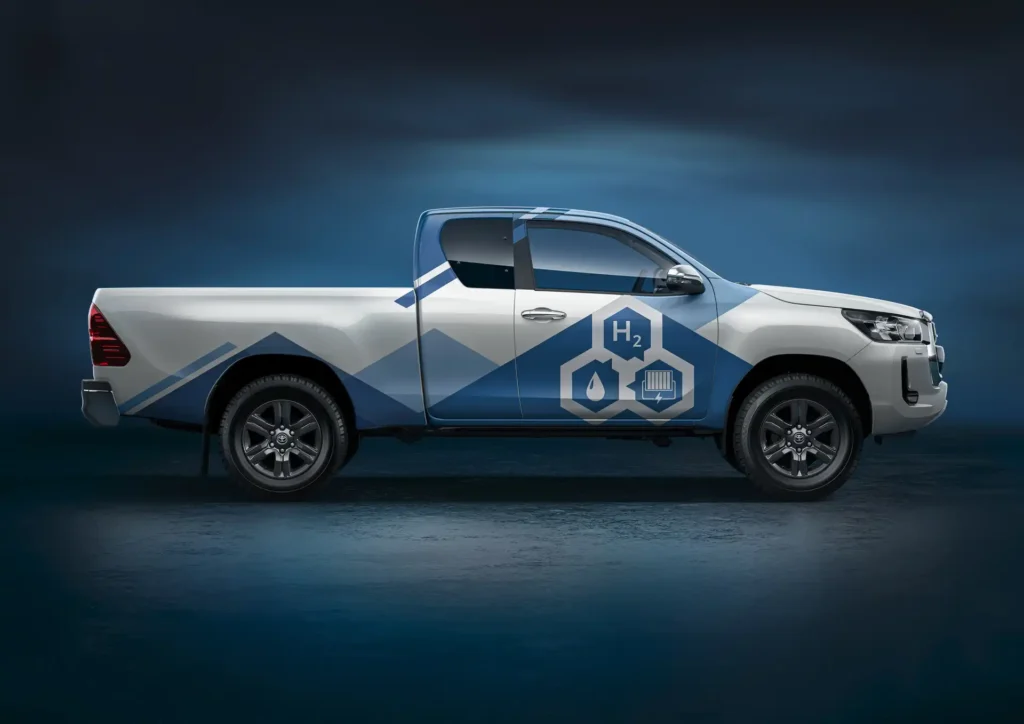2023 Toyota Hilux hydrogen fuel cell version shares FCEV powertrain with Mirai.
While other automakers are putting all their efforts into electric cars, Toyota has not yet given up on hydrogen fuel-powered vehicles (FCEVs). The fact that Toyota is developing a hydrogen-powered pickup truck based on the Hilux shows that.
Called by the name Toyota Hilux H2, this model is currently just a concept car. However, the car will be on the commercial production line in 2023 at the expense of the British government.
This project is carried out by the Advanced Drive Center (APC) under the direction of the British government to develop zero-emissions vehicles in the foggy country. The UK government will pay £11.3 million (approximately $13.86 million) for later-stage research and development as well as bringing the product from the drawing board to the prototype vehicle stage.
2023 Toyota Hilux Pickup Truck
To develop the Hilux H2, Toyota engineers used the Hilux pickup truck as the base. The team will then remove the vehicle’s diesel engine and powertrain, replacing it with a much cleaner system. More specifically, the car will use the second generation FCEV powertrain of Toyota Mirai.
Toyota’s second-generation FCEV powertrain includes a fuel cell, an electric motor and a hydrogen tank, making the Hilux a zero-emission pickup. Interestingly, Toyota chose this powertrain after testing a three-cylinder, hydrogen-powered petrol engine on the Yaris and Corolla.
Currently, Toyota has not announced the specific specifications of the Hilux H2. Meanwhile, Toyota Mirai’s FCEV powertrain produces a maximum capacity of 182 hp and a maximum torque of 300 Nm and only discharges water from the exhaust. In the version using the usual 2.8L turbocharged diesel engine, Toyota Hilux owns a maximum capacity of 201 horsepower and maximum torque of 500 Nm.
Hilux H2
It is expected that the Toyota Hilux FCEV version will also be equipped with all-wheel drive instead of rear-wheel drive RWD like Mirai. With 3 hydrogen fuel tanks, Toyota Mirai can run for a distance of 647 km. However, Toyota Hilux H2 has a higher coefficient of air resistance and weight than Mirai, so the travel distance is likely to be lower.
To develop the Hilux H2, the Toyota Motor Manufacturing plant in the UK collaborated with other companies such as Toyota’s Research and Development Center Europe, Ricardo, ETL, D2H or Thatcham Research. In particular, Ricardo supports the process of integrating fuel cell components into the trapezoidal chassis of the Toyota Hilux. ETL again supports thermal control solutions. D2H is responsible for providing technical services in the field of thermodynamics. Finally, Thatcham Research supports insurance and safety assessments.
Toyota Hilux H2 will be assembled at the plant in Burnaston, UK, in 2023. According to Toyota, the initial goal is to produce the vehicle in low volumes and to study other applications of hydrogen fuel cell technology in the segment. car segment, helping to move towards a carbon-neutral future.
The current generation Toyota Hilux has been around since 2015 with 2 facelifted versions launched in 2017 and 2020. The next generation of this pickup is expected to be “electrified”. Meanwhile, the FCEV version of the Toyota Hilux is expected to have only low output because of the limited network of hydrogen fueling stations.
sudharsan has over a decade of experience covering the breaking news in the auto industry and over ten years of experience writing about cars for magazines, automotive websites, and YouTube videos.
Thank you for following
